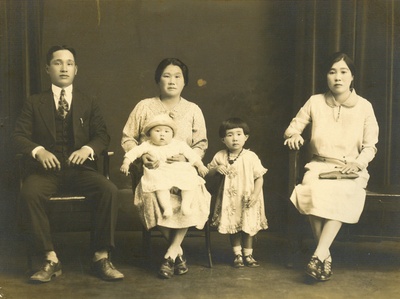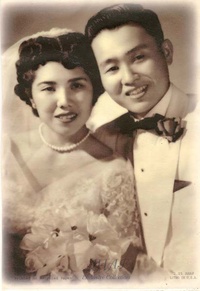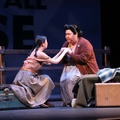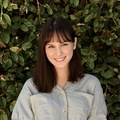Yamato Damashi translates to “Japanese Spirit.” It’s painted in calligraphy on a scroll that hangs in the home of Henry and Helen Yasuda, a reminder of the Japanese cultural values that have sustained them throughout the years—doing one’s best, putting family first, a commitment to education, and expressing gratitude. The Yasudas are among the longest serving volunteers at the Japanese American National Museum, and have shared their knowledge with visitors since the Museum’s grand opening in 1992. Through JANM and organizations such as Nikkei Parents’ Day Coalition which named them Nikkei Parents of the Year in 1996, they help preserve and pass on traditional Japanese values which strengthen the individual, the family, and the Nikkei community. Here is their story, gathered from a recent interview and from Henry’s autobiography, Yamato Damashi.
Henry Shoichiro Yasuda was the eldest of six siblings, born in 1928 in Pasadena, California, and then raised in Mesa, Arizona until the age of 10. A kibei, he was sent to Japan for his education, living with his Issei grandparents who had repatriated after 30 years in the U.S. Initially, Henry endured taunts of “gaijin” from his classmates, but worked hard to achieve Japanese fluency. He soon excelled in his subjects and became the class leader.
Henry went on to pass the entrance exam to the academically demanding Tokuyama Middle School, his father’s alma mater. He boarded there, separated not only from his grandparents but from his parents in America. “It was the loneliest time in my life,” said Henry. “What kept me going was gaman (perseverence), issho ken mei (do your best) and haji (don’t shame your family).”
Henry’s parents, devastated by their internment experience at Crystal City, Texas, decided to return to Japan despite the difficulty of post-war life there. Meanwhile, Henry had already completed two years of college in Japan, but wanted to finish his education in America to benefit from a greater range of opportunities. His father was initially opposed to the idea but eventually gave his son permission, telling him “with your determination, perseverance, and hard work, anything is possible in America.” Henry transferred to UC Berkeley, earning a B.S. in Business Administration in 1953. That’s where Henry met Helen.
Helen Chizuko Inouye, a Nisei, also came from a family of six siblings. Her parents had arrived in America as teenagers and married in Sacramento before relocating to Fresno where they were truck farmers. During the war, Helen’s family was incarcerated in Jerome and Rowher, in Arkansas, leaving briefly to live in Utah. “As long as you didn't come back to the west coast, you could leave camp if you had a sponsor,” said Helen. “We did leave but then my grandfather got sick so we went back to camp.”
The family returned to Fresno in the spring of 1945, before the war ended. Helen recalls, “I was very fortunate because I came from the type of family where, with all this hysteria and everything, our parents hid it very well from us. My parents made sure the family was together. We were all safe and they just kept us all protected.”
At Helen’s high school, she was one of only two Nikkei students. She was a good student and wanted to go on to college. Helen remembers, “my neighbors had a lot to do with convincing my father to allow me to go up to Berkeley.” She felt privileged that her father allowed her to continue her education and enrolled at UC Berkeley in the Spring of 1952, the same year as Henry.
This was during the Korean War. Helen’s mother had passed away and her older brothers had been drafted into the Army. Helen’s sister was living at home, helping their father and younger brothers with the house and farm. But when she got married, Helen had to take a leave of absence from school. “She was nice enough to wait for the semester break for the wedding but told me, ‘you’re going to have to come home.’ I had to help my father.”
By this time, Henry had graduated from UC Berkeley. “I finished in 1953. I’d been drafted but I was already deferred. In those days, if you were in the upper one-fourth of the class, they deferred you until you graduated,” said Henry. He completed basic training at Fort Ord and because of his Japanese language skills, was selected to serve in Military Intelligence as an interrogator and translator. He had a two-week furlough before shipping out which happened to coincide with Helen’s brother’s wedding. “They invited me to come to the wedding,” remembered Henry. “So I went up there, saw Helen, the wedding was over, we were dancing and all of a sudden, we decided to get married.”
The story gets even better. “So that night, I took her home and went into her house and her father was already sleeping,” Henry recalled. “We went to his bedroom and Helen said, ‘we’re going to get married.’ He fell out of bed, finally saying, ‘well, I thought you were going to get married sooner or later but not now that you’re going overseas. Why don’t you wait?’ We said, ‘we just can’t wait.’ He said okay.”
There was no time to waste. In a single afternoon in Little Tokyo, Henry went to the Buddhist temple to schedule a wedding ceremony, “as soon as you can, this weekend!” He arranged for a wedding photographer, booked a reception for twenty guests at a chop suey house, and reserved rooms at the Miyako Hotel for family coming from Fresno. Helen was every bit as efficient. As she remembers it, “my mother had passed away by then so I went shopping by myself and picked up a wedding gown that fit just right. Then I got the dresses for my bridesmaids off the rack, made the flower girl’s outfit—it didn’t take long. Everything got ready on time.” They were married at Nishi Hongwanji Buddhist Temple on May 15, 1954 in Little Tokyo, just steps away from where the Japanese American National Museum stands today.
© 2011 Japanese American National Museum








